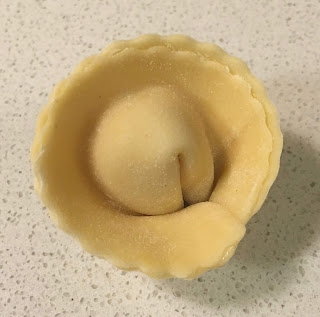A Twisted Tale
Wednesday, January 22, 2020
Tortes, tortellini, tortelloni, tortas… what could they possibly have in common? I assumed that there might be an etymological answer… after all, all these foods come from countries who speak romance languages. They all have some connection to Ancient Rome. They all involve flat, round starchy products, often stuffed with something else. Did their stuffing have something to do with their linguistic connections?
What about the legal term, “torts” …as in “torts and malfeasances?” Not a very promising direction. What about “torture,” or even “tortoises?” Torture seemed an unlikely match to all those much more appealing foodstuffs. As for tortoises… they are sort of round, and might appear stuffed, if you look at them the right way. No… that’s pushing it too far.
At first glance, it was a little odd that so many seemingly unrelated foods might share a linguistic ancestor. A quick look at the Oxford English Dictionary and the Oxford Dictionary of English Etymology should have helped, right? Alas, these reference books didn’t address any of my culinary concerns… but they did say that modern words are descended from a Latin word for twisting.
Frankly, I wasn’t getting the connection to the various foodstuffs that provoked my question in the first place. I dug out my Latin-English dictionary. AHA! Ancient Romans used to bake twisted breads called tortae. What, exactly was a twisted bread? Think challah.
Along the way, I discovered that bread baking, for the Romans, changed in response to techniques they learned from the Greeks. It’s often the case that food culture changes in response to historical meetings of different cultures (wars, colonizations, and immigration have almost always led to the adoption—and adaptation—of new foods). Maybe the spread of the Roman Empire was, in some way, responsible for all these related food names?
Before the Romans colonized Greece, they ate their grains primarily in the form of puls or pulmentum… gruel-like dishes. Italian polenta is descended from those ancient dishes (and, obviously, couldn’t be made from corn—maize, that is—until long after the fall of the Roman Empire; it was not available until the New World was discovered). The new breads they baked were round (carbonized loaves have been recovered from the volcanic ashes of Pompeii)… so something about roundness and baking must have been carried to the foods of countries whose language had evolved from Latin.
This was more promising. The dishes did not travel from place to place, and then evolve into new dishes. Sausages (and words for sausages) traveled the same way— but, while they changed to reflect different tastes and availability of ingredients, they still remained sausages. All of the tort-related foods became something very different from the original Roman bread. So, the form—round, somewhat flat, and dense—seems to have traveled with the old Latin-based name to various countries. The names and attributes were adopted, not the food itself.
“Torta” is Italian for cake… not too much of a stretch from Latin tortae. They are round and flat. Pizza rustica, for example, is a dense rich torta; it’s a savory cheesecake wrapped in a pastry crust. Germanic tortes—like the Viennese sacher torte—are also round and flat. They’re as dense as the pizza rustica, but sweet. They’re dense because they contain ground nuts instead of flour (so there’s no gluten to hold bubbles of carbon dioxide—that would otherwise be produced by yeast or chemical leavening).
In Spain, tortilla (the diminutive of cake) follows the plan, but stays on the savory side of things. Their tortilla de patatas is a dense flat omelet, layered with sliced potatoes, sometimes enriched with bits of chorizo sausage. It is served hot or cold, cut in wedge-shaped slices—just like a cake.
Only the name “tortilla” made it from Spain to Mexico. The conquistadors saw the flat breads of the Aztecs, made of nixtamalized corn, and gave them the only name that seemed appropriate. It was easier for them than adopting the Nahuatl word for the traditional flatbread, tlaxcalli. The round and layered form is reflected by Mexican tortas, but they are not cakes, this time. They’re sandwiches—fluffy buns, over-stuffed with an assortment of meats, cheeses, beans, sliced avocados, and chiles. While the tortillas, especially the flour tortillas used for burritos, marked the union of Spanish and Indian ideas about food, tortas are probably the result of the French occupation of Mexico. French colonials in Indochina (Vietnam) created similar sandwiches there—bánh mi—but they used baguettes instead of the round buns of Mexican tortas. Perhaps that’s why the Romance-language “torta” was never used there.
What about some of the Italian stuffed pastas that initiated this question? Tortelloni are circles of pasta dough, stuffed with bland filling, such as ricotta cheese. The name just means “little cake.” Tortellini are even smaller, and usually containing richer fillings, like finely ground seasoned meat.
Etymologists are uncertain about the roots of the name “tortoise.” Some think the name is connected to the twisted-looking legs of these animals. I like to think—probably with no linguistic justification, whatsoever—that their bumpy domed shells reminded the ancients of tortae, twisted loaves of bread.


0 Comments:
Post a Comment
Subscribe to Post Comments [Atom]